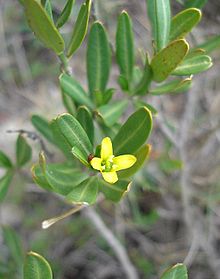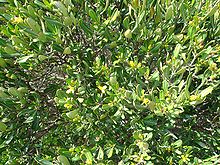Cneorum tricoccon
This article needs additional citations for verification. (October 2014) |
| Cneorum tricoccon | |
|---|---|

| |
| Scientific classification | |
| Kingdom: | Plantae |
| Clade: | Tracheophytes |
| Clade: | Angiosperms |
| Clade: | Eudicots |
| Clade: | Rosids |
| Order: | Sapindales |
| Family: | Rutaceae |
| Genus: | Cneorum |
| Species: | C. tricoccon
|
| Binomial name | |
| Cneorum tricoccon | |
| Synonyms[1] | |
| |

Cneorum tricoccon, the spurge olive,[2] is a small shrub of the family Rutaceae, native to Europe in the western Mediterranean Region.[2][3]
Description[edit]
Cneorum tricoccon reaches an average of 0.6 metres (2.0 ft) in height and is in leaf all year. The plant which is nearly round and evergreen in color. The yellowish flowers occur from June to July, and their seeds ripen from August to September. The spurge olive plant is also hermaphroditic.
Cneorum tricoccon prefers light sandy soils that are common in the Mediterranean and also requires soils that drain particularly well. Spurge olive must have considerable sunlight to grow, and often stunts when in much of shade.
Uses[edit]
Its fruit has no food value. The plant is rich in tannin, and can be used as a source of fuel.
References[edit]
- ^ "The Plant List: A Working List of All Plant Species". Retrieved 21 October 2014.
- ^ a b "Plants for a Future". Retrieved 6 November 2014.
- ^ "Breakage of Mutualisms by Exotic Species: The Case of Cneorum tricoccon L. in the Balearic Islands (Western Mediterranean Sea)" Journal of Biogeography. Retrieved 2015-11-08.
External links[edit]
 Media related to Cneorum tricoccon at Wikimedia Commons
Media related to Cneorum tricoccon at Wikimedia Commons
